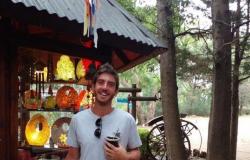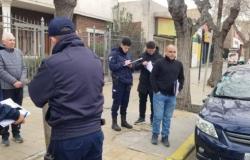More than 40 neighborhoods of the western cordon under water, with 36,890 homes distributed in 1,296 affected blocks and the mass exodus of more than 150 thousand residents in a few hours, are some of the figures that describe the apocalyptic days that the city of Santa Fe experienced as of April 29, 2003.
A catastrophe that could have been avoided. A latent and present pain in the collective memory. Mailín Sylvester puts his art at the service of memory and in May he premiered his latest work “Water and Garlic” which contextualizes the feeling of abandonment experienced by a family victim of tragedy. A deep, human and sensitive work. The playwright spoke with Mirador Provincial.
Mailín Sylvester
-What led you to write a play about the last great natural disaster that the province experienced?
-In theater, themes are an excuse to talk about what happens to us. And there are many topics that have not been talked about, that are there waiting for someone to bring them up. They are two different things that were found. That is to say, it is not that there are no organizations and groups that remember and continue to raise the flags of memory for the Santa Fe flood, of course there are. There are also documentaries, books, articles, but I did not specifically remember a work that talks about it, and it seemed like an important topic since it allowed me to talk about current things, because we cannot read the present without reading the past. When I began to write this work we were in the midst of the burning of the Wetlands. Those of us from Rosario remember it well, although at one point we even a little bit resigned ourselves to suffering from it. It was impressive to have injustice so much in front of your face and not be able to do much. The surprising thing about that phenomenon was that the majority of the population felt like victims, and ignored. Nothing was happening. No type of solution was generated from the government, where our health and our natural resources should be defended. We were suffocating, our eyes were burning, there were mobilizations, groups that emerged as a result, and nothing seemed to change for something that was urgent. Let’s say that both situations – that of Santa Fe in 2003 and that of Rosario in 2020 – evoked each other. In this context, I took that topic to talk about things that were happening and continue to happen. Also address the problem of the absence of the State not only in borderline issues, but in those that are a continuum… for example, what happens with housing? What happens to the lives of families, their stories, that are forgotten? What do they make us forget to continue in this maelstrom of life, going out to work, to do what we have to do?
-How was the documentation process for putting together the story?
-First, before anything, it was remembering, thinking, where was I when it happened? It was important to locate this, to understand a little why an event like that came to mind, suddenly, without having had it in mind. It was something that did not explicitly touch me closely, although I still perceive it as relatively close. I was a preteen and in elementary school. I remember that I absorbed the problems of the political situation at that time, and I remember what was said. At school we collected donations, it was talked about on the news, but I was a child and it didn’t really touch me closely.
Subsequently, I started looking for news videos on YouTube, testimonies, and newspaper notes. It was hard, I cried a lot. I realized that my memories did not capture the dimensions of the matter. I kinda thought, what did I get myself into?! But anyway, I continued… I turned to a close friend, from Santa Fe, who told me about his and his family’s experience and some of his stories are included in some way in the work.
It was also necessary to consult maps to understand the event geographically, where the water was, the causes and to be able to locate everything with a certain sense.
With the cast addressing the text, we did a new kind of research, collecting the memories of each one, since we are different ages and are from different places in the province and surrounding areas, later we read books, articles, we researched songs that talk about it, documentaries, to continue soaking up the subject, which would help us understand the psychologies that we would address from a multitude of places.
-It was an event that hit the province more than two decades ago, do you think that something changed in the political arc to prevent or contain a similar catastrophe?
-There are still political and economic interests and a desire to leave everything important to the last minute, since what ultimately costs is the life of the people. Blaming nature is an excuse. Tools have existed for some time to prevent and take action against inevitable events, and to avoid avoidable things. The flooding of Santa Fe occurred due to enormous negligence on the part of the State, because the leaders were aware of what could happen and bet the lives of the citizens to save a few mangoes, it is unforgivable. And survival doesn’t have to remain the priority. The priority is to have quality of life, to live with dignity. For a family, a person, to lose everything they worked hard to achieve, everything they have, translates into subtracted life time.
The assembly of the team
-Returning to the work, how was the work team assembled?
-It is made up of María Victoria Vitta and Javier Fernández, two great actors with whom we have already shared projects, in the characters of Leticia and Ambrosio, respectively. María Victoria also holds the role of assistant director. We were joined by the magnificent Fátima Sadín, playing Rigoberta, and Luciano Fernández, with whom we did a tour of the Clown in the past, as Second. I am very happy with this cast since they have put their body and mind into carrying out this project. It is also a beautiful work group with whom we have a lot of fun and a great human group. We have accompanied each other a lot in the artistic process, as well as in the research and emotions that these delicate topics raise. However, today it is difficult to make and produce theater, especially economically speaking, of course, and the truth is that finding each other, finding each other, is invaluable, and being able to take a journey of months together, accompanying and supporting us in the midst of the economic and social that we are going through. I have no words to describe what is appreciated.
-What resonances are you finding in the public?
-We have had few functions so far, I can’t talk much about it forcefully. Mixed feelings, more than anything. But I prefer not to predispose the future public with anything, to see what happens to them. The reading of a work is always completed by the viewer, with his or her subjectivity, and all readings are valid and valuable.
-Is it important to fictionalize the tragedies that happen to us as a society?
-I think so. It is important to remember those things that mark us, because they are unavoidable, because they are there. It is important, because silencing is something that comes from others, from outside, and the exercise we need is to bring it back, to keep it in mind. It is painful, without a doubt, but that is why we have art, to be able to talk about the things that hurt. Because if not, they stay there, roaming around and destroying everything. Not talking about history does not make it disappear, it only turns it into an entity that is external to us and harms us. If history is part of us, why not take it in our hands, claim it, give our opinion, and be able to make with it the present we want?
BIO
Mailín is an actress and director who graduated from the Provincial School of Theater and Puppetry of Rosario. During her childhood and pre-adolescence she studied theater at the Ernesto de Larrechea Municipal School of Dance and Performing Arts. Her last theatrical works were “El Labyrinth Towards Simplicity”, a one-woman show of her own authorship starring María Victoria Vitta, and “La Casa del Lago de Constanza”, which she performed at the invitation of the Colarratón group. In both she served as director.
Synopsis
In 2003, a family from Santa Fe must face the abandonment of the State in the midst of the enormous flood. Overwhelmed but without losing their humor, they try to rebuild their home in any way possible.
File
Direction and dramaturgy: Mailín Sylvester.
Performances: Javier Fernández, Luciano Fernández, Fátima Sadín and María Victoria Vitta.
Performances: Saturdays in June at 9 p.m., Sala La Morada (San Martín 771).
CULTURE
More news on this topic






